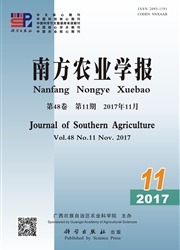

 中文摘要:
中文摘要:
在单因素实验的基础上,结合Box-Behnken试验设计原理,采用三因素三水平的响应面分析法,以Na Cl浓度、AMP浓度、温度为自变量,剪切力和蒸煮损失为响应值进行回归分析。根据统计模型发现Na Cl浓度、AMP浓度、温度3个因素对剪切力和蒸煮损失均有显著影响。由模型的响应曲面图及其等高线图,确定猪肉嫩度改善的最佳工艺参数为:Na Cl浓度4.15%,AMP浓度22.27 mmol/L,温度16.70℃。在此条件下得到猪肉剪切力的平均值为625.281 g,蒸煮损失为8.074 38%,与理论预测值基本吻合,说明采用响应面法对猪肉嫩度改善的条件进行优化是合理可行的。
 英文摘要:
英文摘要:
Based on the single factor experiments,Na Cl concentration,AMP concentration and temperature were selected as independent variables for a three-level Box-Behnken experimental design. The shear force and cooking loss were selected as the response values for regression analysis. The statistical models showed that all independent variables had significant effects on shear force and cooking loss,and optimal values were determined with three-dimensional response surface diagrams. The optimized conditions were: Na Cl concentration 4. 15%,AMP concentration 22. 27 m M and temperature of 16. 70 ℃. Under the above conditions,the observed shear force and cooking loss were625. 281 g and 8. 07438%,respectively,which was very close to their predicted values,indicating the good applicability and feasibility of RSM on improving pork tenderness.
 同期刊论文项目
同期刊论文项目
 同项目期刊论文
同项目期刊论文
 Effect of ?nal cooked temperature on tenderness, protein solubility and microstructure of duck breas
Effect of ?nal cooked temperature on tenderness, protein solubility and microstructure of duck breas Changes in actomyosin dissociation and endogenous enzyme activities during heating and their relatio
Changes in actomyosin dissociation and endogenous enzyme activities during heating and their relatio 期刊信息
期刊信息
